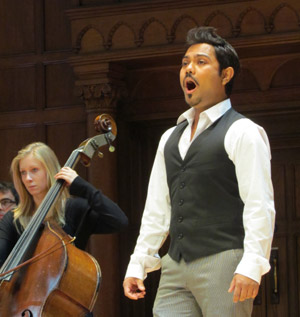York experts' role in revealing people's hidden natural abilities
Two University of York academics make significant contributions to tonight’s episode of the Channel 4 programme Hidden Talent, the show about helping people unlock their skills in a number of areas, including climbing, language learning, lie detection, freediving and singing.
 Head of the
University’s Department of Electronics, Professor David Howard appears in
tonight’s episode which features opera singing and Dr Tom Hartley, of the
Department of Psychology devised a test to assess people’s natural ability for
navigation.
Head of the
University’s Department of Electronics, Professor David Howard appears in
tonight’s episode which features opera singing and Dr Tom Hartley, of the
Department of Psychology devised a test to assess people’s natural ability for
navigation.
As a researcher in the acoustics of singing in the Audio Laboratory in the Department of Electronics, Professor Howard provided scientifically-based measurements to help to evaluate the singing potential of non-singer candidates. A “winner” then has his or her talent unlocked as an opera singer. Professor Howard helped to find the winner from the final 12 hopefuls from a total of 800 initial participants. The selection was based on various scientific measurements used to indicate the potential of the candidate’s vocal instrument for opera singing. The winner then receives six months of singing lessons to prepare for the opera stage.
The singing voice has three main elements: the power source (lungs and breathing), the sound source (the vibrating vocal folds in the larynx or voicebox in the neck), and the sound modifiers (the throat, mouth and nose).
Professor Howard says: “Not everyone will be a great singer and this is in part due to the vocal instrument we are born with, which has to have some potential, as well as training and good listening ears.
“For Hidden Talent, I had to establish whether or not the candidates had a promising natural vocal instrument. Bear in mind that to get to the final twelve, candidates had already been evaluated qualitatively by singing teachers.”
Three key elements of the vocal instrument were explored scientifically.
- The pitch and loudness range that candidates could achieve with their sound source were measured and compared across the group
- The detailed nature of the closing and opening of the vocal folds was quantified by means of an electrolaryngograph, which is used in Speech and Language clinics
- The acoustic effect of the sound modifiers was measured to assess its potential for good projection of sound
Based on these measurements, which were combined to produce a rank ordering, the final decision was made on who the winning candidate was. This is not a common approach used to consider the potential of the vocal instrument and therefore the whole experience was rather experimental in itself. Professor Howard was asked to go back during the six-month training period for the winner to check on progress using the same measurement techniques; you will have to watch to find out the result.
Meanwhile, Dr Hartley developed the Four Mountains test to assess the spatial abilities of 500 volunteers. It is designed to tap a particular type of spatial memory that is thought to depend on the hippocampus, part of the brain that is involved in forming new memories, in keeping track of where we are and in finding our way around.
Dr Hartley says: “We are using the test to find out what makes one person so much better than another at recognising places. Are great navigators born or made?
“The results of the Hidden Talent experiment will shed new light on this and in combination with brain imaging experiments at the York Neuroimaging Centre we hope to discover soon whether the accuracy of our memory for places is linked to variations in the brain's structure.”
Hidden Talent is on Channel 4 tonight at 9pm.
Further information
